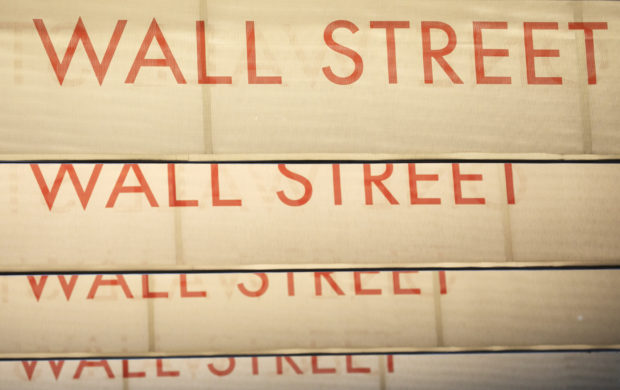
Signs for Wall Street are shown, Thursday, July 30, 2020, in New York. Stocks are falling on Wall Street Thursday after reports showed that layoffs are continuing at a stubborn pace and that the U.S. economy contracted at a nearly 33% annual rate in the spring. (AP Photo/Mark Lennihan)
NEW YORK — The S&P 500 pulled back from its newly set record on Wednesday after a meandering day of trading took a late turn lower.
The benchmark index fell 14.93 points, or 0.4%, to 3,374.85, a day after it wiped out the last of its losses created by the pandemic and surpassed its Feb. 19 peak.
The Dow Jones Industrial Average also gave up an earlier gain and lost 85.19, or 0.3%, to 27,692.88. The Nasdaq composite dropped 64.38, or 0.6%, to 11,146.46.
Indexes turned lower in the afternoon after the Federal Reserve released the minutes from its latest policy meeting.
The central bank has been one of the main pillars propping up the market after it slashed short-term interest rates to their record low and essentially promised to buy as many bonds as it takes to keep markets running smoothly.
The Fed’s minutes showed again that policy makers are finding it difficult to forecast the path of the economy, which will depend greatly on what happens with the virus.
Treasury yields also rose after the minutes showed, among other things, that several Fed officials said trying to set upper limits for yields beyond ultrashort-term rates would provide only a modest help. Some investors have been speculating that could be a step the Fed would take next to help the economy.
The yield on the 10-year Treasury rose to 0.68% from 0.67% late Tuesday. It had been as low as 0.64% earlier in the morning.
Across the stock market, momentum has largely remained solid. But it’s slowed recently after roaring back from a terrifying plummet of nearly 34% in February and March. Trading has been so tepid that it took the S&P 500 several attempts to break its record after pulling within 1% of the mark a week and a half ago.
“The elevator went down very quickly, so to speak,” Nancy Davis, chief investment officer of Quadratic Capital, said of the market’s plunge earlier this year. “And now we’ve been climbing the stairs back up, and we’re higher than we were before.”
This is a traditionally slow time of the year for stocks, and the market is also still in wait-and-see mode on several fronts.
Investors still seem to believe that Congress and the White House will reach a deal to deliver more aid to the economy after federal unemployment benefits and other stimulus expired.
Democrats and Republicans have been stuck at an impasse and sniping back and forth, but investors are seeing speculation about a possible scaled-down version of aid passing Congress, said Willie Delwiche, investment strategist at Baird.
Beyond Capitol Hill, investors are also waiting for more developments on the rising tensions between the United States and China. The world’s largest economies have longstanding trade issues, and President Donald Trump has recently been targeting Chinese tech companies in particular.
Also hanging over the market is the upcoming U.S. election, with the big changes in tax and other policies that it can create. Democrats formally nominated Joe Biden late Tuesday to run against Trump for the White House in November’s election.
Earnings reporting season for big U.S companies has nearly wrapped up, with businesses in the S&P 500 on track to report a sharp decline in their profits for the spring, but not as bad as Wall Street expected. More than 93% of the earnings reports are in, and the index is on pace for a roughly 33% drop from the prior year.
Target jumped 12.7% for the biggest gain in the S&P 500 after it reported results for the spring that easily beat Wall Street’s expectations.
But TJX, the operator of T.J. Maxx and Marshalls, slumped 5.4% after its results fell short of analysts’ forecasts.
Apple continued its run of dominance and rose 0.1%. Earlier in the day, its total market value briefly topped $2 trillion, the first time a U.S. company has crossed that threshold. It’s the latest accolade for Big Tech, which has thrived as the pandemic accelerates work-from-home and other tech-friendly trends.
“While we talk about the S&P 500 at an all-time high, really it’s a handful of stocks at all-time highs,” said Delwiche. “Maybe beyond the headlines of what the index is doing, stocks are actually endorsing the bond market view that there’s still a lot of work to be done with respect to a Main Street recovery, and that message gets overwhelmed in a cap-weighted index like the S&P 500, where you have five to seven stocks rallying and that makes the index look really good.”
In European stock markets, the German DAX returned 0.7%. The French CAC 40 rose 0.8%, and the FTSE 100 in London added 0.6%.
In Asia, Japan’s Nikkei 225 rose 0.3%, and South Korea’s Kospi gained 0.5%. Stocks in Shanghai slumped 1.2%, and the Hang Seng in Hong Kong lost 0.7%.
Benchmark U.S. crude oil rose 4 cents to settle at $42.93 per barrel. Brent crude, the international standard, fell 9 cents to $45.37 a barrel.